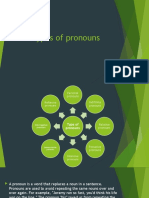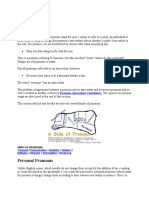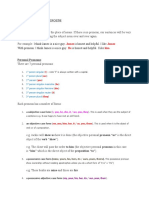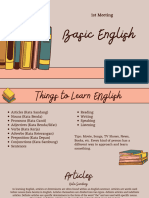The Boy Said That Was Tired. He: in This Example, The Pronoun "He" Is Refer-Ring Back To The Noun (Antecedent) "Boy."
The Boy Said That Was Tired. He: in This Example, The Pronoun "He" Is Refer-Ring Back To The Noun (Antecedent) "Boy."
Uploaded by
YogiAfriYendraCopyright:
Available Formats
The Boy Said That Was Tired. He: in This Example, The Pronoun "He" Is Refer-Ring Back To The Noun (Antecedent) "Boy."
The Boy Said That Was Tired. He: in This Example, The Pronoun "He" Is Refer-Ring Back To The Noun (Antecedent) "Boy."
Uploaded by
YogiAfriYendraOriginal Title
Copyright
Available Formats
Share this document
Did you find this document useful?
Is this content inappropriate?
Copyright:
Available Formats
The Boy Said That Was Tired. He: in This Example, The Pronoun "He" Is Refer-Ring Back To The Noun (Antecedent) "Boy."
The Boy Said That Was Tired. He: in This Example, The Pronoun "He" Is Refer-Ring Back To The Noun (Antecedent) "Boy."
Uploaded by
YogiAfriYendraCopyright:
Available Formats
WHAT IS A PRONOUN?
A pronoun is a word that refers to or takes the place of a noun. The noun being referred to is
called the antecedent. The identity of the pronoun is made clear by the antecedent. For exam-
ple:
There are many different types of pronouns: personal, possessive, reflexive, in-
tensive, demonstrative, interrogative, relative, indefinite, and reciprocal.
The boy said that was tired. he
In this example, the pronoun he is refer-
ring back to the noun (antecedent) boy.
Pronoun Antecedent
Personal Pronouns are pronouns that refer to a specific person or thing in a sen-
tence and can be divided into two groups: nominative and objective.
Nominative personal pronouns can act as the subject of a sentence (I, you, he, she, it, we,
they). For example:
I went to the store after work. You should not go to class if you are sick.
Objective personal pronouns, on the other hand, act as objects of a sentence (me, you, him,
her, it, us, them). For example:
Alex came out with Joe and me. Melissa really likes him.
Possessive Pronouns are pronouns that show ownership; in other words,
something belongs to someone else (my/mine, your/yours, his, her/hers,
its, our/ours, their/theirs). For example:
That book is mine . Their shoes are under the bed.
Reflexive Pronouns are pronouns that are used to show that the subject of
the sentence is receiving the action of the verb (myself, yourself, himself,
herself, itself, ourselves, themselves). For example:
She can handle the situation herself. We can write the paper ourselves.
Personal
(Nominative)
Personal
(Objective)
Possessive Reflexive
I me my/mine myself
you you your/yours yourself
he him his himself
she her her/hers herself
it it its itself
we us our/ours ourselves
they them their/theirs themselves
Intensive Pronouns are pronouns that are used only to place emphasis on the
subject and are not essential to the meaning of the sentence. Note: These
pronouns look the same as reflexive pronouns, but they act differently in the
sentence and are always placed next to the subject that they are emphasizing (myself, yourself,
himself, herself, itself, ourselves, themselves). For example:
You yourself must go to the police station.
*Here, the pronoun yourself is used only to place emphasis on the subject you and does not change the meaning of the sentence.
Demonstrative Pronouns are pronouns that are used to identify nouns and
answer the question which one? (this, that, these, those) For example:
These are the books that John was talking about.
*Here, the pronoun these identifies which books John was talking about.
Interrogative Pronouns are pronouns that are used only in reference to a
question (who, what, which, whom, whose). For example:
Which one of these pens is yours?
Who is that girl?
Relative Pronouns are pronouns that are used to connect clarifying infor-
mation to nouns or other pronouns within a sentence (who, that, which,
whom, whose, whoever, whichever, whomever, whatever).
Who vs. Whom
Whom is used when referring to an object.
With whom did Alex go out?
The letter should be addressed to whom?
Who is used when referring to a subject.
Who went to the store after work?
Who sings this song?
Note: Refer back to the Personal Pronouns section on page 1 of this skills page. Who works like a nominative pro-
noun, while whom works like an objective pronoun.
Indefinite Pronouns are pronouns that are used in reference to a person
or thing that is not specific or not known. Indefinite pronouns are also
used to identify a general group of people or things (i.e. everyone, everybody, anyone, anybody,
somebody, most, all, each every, some, none, one, few, both, many, several). For example:
Everybody has to take the Writing Proficiency Examination in order to graduate.
All of the seniors were excited for graduation.
Note: Singular indefinite pronouns must always take singular verbs. For more information on indefinite pronouns, see
the skills page on Pronoun Antecedent Agreement.
Reciprocal Pronouns are pronouns that are used to refer to a mutual
set of people (each other, each others, one another, one anothers).
For example:
We need to help one another survive.
They had remembered each others phone numbers.
Note: It is also important to be clear when using pronouns. For example: He really should not do that.
(Who is he? What is that?)
For more information, please refer to the skills page on Pronoun Antecedent Agreement.
Last modified 8/11/11
Who vs. That
That vs. Which
Who is used to refer to people or animals with names.
Liz, who wrote the review, got in trouble.
That is used to refer to things.
The paper that I wrote last night vanished.
That is used in essential clauses (clauses necessary for understanding the subject of a sentence).
The pizza parlor that is down the street from the college is great.
*The subject is unclear without the additional information. Which pizza parlor? The one that is down the street from the college.
Which is used in nonessential clauses (clauses unnecessary for understanding the subject of a sentence).
My moms jewelry was stolen, which upset her very much.
*The subject is clear without the additional information.
Note: For more information on essential and nonessential clauses, see the skills page on Independent and Dependent
Clauses.
You might also like
- The Boy Said That Was Tired. He: in This Example, The Pronoun "He" Is Refer-Ring Back To The Noun (Antecedent) "Boy."Document3 pagesThe Boy Said That Was Tired. He: in This Example, The Pronoun "He" Is Refer-Ring Back To The Noun (Antecedent) "Boy."alirazaNo ratings yet
- Pronouns PDFDocument3 pagesPronouns PDFgleeNo ratings yet
- Pro ZanaDocument8 pagesPro ZanaSpadzonNo ratings yet
- N-P AgreementDocument12 pagesN-P AgreementDr. C. Jothi ENG-STAFFNo ratings yet
- Pronoun: What Is A Pronoun?Document4 pagesPronoun: What Is A Pronoun?Retno Dhini LarasatiNo ratings yet
- Jeremy His (Jeremy's) : 1. Personal PronounsDocument9 pagesJeremy His (Jeremy's) : 1. Personal PronounsSanuNo ratings yet
- Week 2 - S1 - PronounsDocument12 pagesWeek 2 - S1 - PronounsTechnical InformationNo ratings yet
- 10 Kinds of Pronouns in EnglishDocument5 pages10 Kinds of Pronouns in EnglishRizal TambunanNo ratings yet
- Personal Pronouns: PronounDocument5 pagesPersonal Pronouns: PronounHARISH KUMAR SHARMA0% (1)
- Types of PronounsDocument7 pagesTypes of PronounsYusuf SsessangaNo ratings yet
- REASERCHDocument21 pagesREASERCHRichelle MoralesNo ratings yet
- A PronounDocument4 pagesA PronounSieg GolezNo ratings yet
- Pronoun - Types of Pronouns With Useful Examples - Pronouns ListDocument16 pagesPronoun - Types of Pronouns With Useful Examples - Pronouns ListAdelina Elena Ghiuţă100% (1)
- List of ProunounsDocument3 pagesList of ProunounsGabi CosminNo ratings yet
- Pronouns and Types ExplanationDocument3 pagesPronouns and Types Explanationzander_knighttNo ratings yet
- 10 Kinds of PronounsDocument3 pages10 Kinds of PronounsCOMPRA CLOVIN MARI P.No ratings yet
- Types of PronounsDocument22 pagesTypes of PronounsImanNurAnaqiIshakNo ratings yet
- PRONOUNSDocument22 pagesPRONOUNSDAYANA ABRIL VALENZUELANo ratings yet
- Pronoun 72 2 1 181671730318554Document8 pagesPronoun 72 2 1 181671730318554sudheeshnakolli2000No ratings yet
- Pronoun Cases and Types English Composition 1Document5 pagesPronoun Cases and Types English Composition 1Helen ZakiNo ratings yet
- Pronoun: They Is A Pronoun Referring To Someone, But Who Are They? Cows? Whom Do They Represent?Document7 pagesPronoun: They Is A Pronoun Referring To Someone, But Who Are They? Cows? Whom Do They Represent?Tope Fatunbi StamNo ratings yet
- Types of PronounsDocument5 pagesTypes of PronounsImran SiddNo ratings yet
- PronounDocument4 pagesPronounmohammadadan424No ratings yet
- PronounDocument5 pagesPronounMathew V SajiNo ratings yet
- Pronouns 2Document16 pagesPronouns 2Nicole LelisNo ratings yet
- Types of Nouns: Demonstrative PronounsDocument12 pagesTypes of Nouns: Demonstrative Pronounsanon_132777102No ratings yet
- Parts of SpeachDocument6 pagesParts of Speachnavadeep149No ratings yet
- Parts of Speech Rejoice & Happy After Seeing This Type of Late ST TechnologyDocument18 pagesParts of Speech Rejoice & Happy After Seeing This Type of Late ST TechnologyKrishan GuptaNo ratings yet
- Week 3: Parts of Speech: PronounsDocument33 pagesWeek 3: Parts of Speech: PronounsVivian MwangiNo ratings yet
- EnglishDocument13 pagesEnglishJazzy Lyle SamsonNo ratings yet
- Subject Pronoun: (Subjective Case)Document5 pagesSubject Pronoun: (Subjective Case)Arun KumarNo ratings yet
- List of PronousDocument4 pagesList of PronousWhy ShortNo ratings yet
- 2 Forum InglesDocument4 pages2 Forum InglesRaimundo AfonsoNo ratings yet
- They Is A Pronoun Referring To Someone, But Who Are They? Cows? Whom Do They Represent? Sloppy Use of Pronouns Is UnfairDocument6 pagesThey Is A Pronoun Referring To Someone, But Who Are They? Cows? Whom Do They Represent? Sloppy Use of Pronouns Is UnfairAn NguyenNo ratings yet
- Looking For ReferencesDocument24 pagesLooking For ReferencesSorat AbdulsataNo ratings yet
- PRONOUNSDocument21 pagesPRONOUNSJoseph Christian TrinidadNo ratings yet
- PronounsDocument10 pagesPronounsceonelmathew2005No ratings yet
- BasicDocument97 pagesBasicViviana Moreno NavarroNo ratings yet
- They Is A Pronoun Referring To Someone, But Who Are They? Cows? Whom Do They Represent?Document6 pagesThey Is A Pronoun Referring To Someone, But Who Are They? Cows? Whom Do They Represent?Nurul FathiniNo ratings yet
- PronounsDocument4 pagesPronounspalomaresjay0No ratings yet
- Noun PhrasesDocument24 pagesNoun PhrasesFaiza ShafiqueNo ratings yet
- Personal Pronouns: Three Grammatical PersonsDocument7 pagesPersonal Pronouns: Three Grammatical PersonsJohn Alvin de LaraNo ratings yet
- Types of PronounsDocument11 pagesTypes of PronounsReynaldo Aluyen Guinoden Jr.No ratings yet
- Technical Writing 1 Prelim Module For StudentsDocument10 pagesTechnical Writing 1 Prelim Module For StudentsTayaban Van GihNo ratings yet
- Pronoun PDFDocument10 pagesPronoun PDFJhona Joyce Barron WPNo ratings yet
- Pronoun: Alfian Widya Dwi Ayuni Rega Giri PrakosoDocument25 pagesPronoun: Alfian Widya Dwi Ayuni Rega Giri PrakosoAlfian MilitanNo ratings yet
- The Quick Answer: Types of PronounsDocument3 pagesThe Quick Answer: Types of Pronounssheree gaye orenyaNo ratings yet
- They Is A Pronoun Referring To Someone, But Who Are They? Cows? Whom Do They Represent? Sloppy Use of Pronouns Is UnfairDocument4 pagesThey Is A Pronoun Referring To Someone, But Who Are They? Cows? Whom Do They Represent? Sloppy Use of Pronouns Is UnfairJoseph SarzaNo ratings yet
- Lets Learn PronounsDocument3 pagesLets Learn PronounsAllen AdrienNo ratings yet
- English Pertemuan 1Document15 pagesEnglish Pertemuan 1Aurel ArafanyNo ratings yet
- Parts of Speech GomezDocument25 pagesParts of Speech GomezsingcosweindinglasaNo ratings yet
- Pronouns WPS OfficeDocument21 pagesPronouns WPS OfficeYukino MichinariNo ratings yet
- PronounsDocument10 pagesPronounsJustine Maria Ira AmenNo ratings yet
- Parts of Speech PronounsDocument4 pagesParts of Speech PronounsMat DaudNo ratings yet
- ENGLISH 1N (Remedial English) The Parts of SpeechDocument9 pagesENGLISH 1N (Remedial English) The Parts of Speechnaldima06No ratings yet
- List of PronounsDocument4 pagesList of PronounsGeena78No ratings yet
- Nisha Arshad Roll No038Document8 pagesNisha Arshad Roll No038zohaibx64No ratings yet
- Englishppr1 2Document117 pagesEnglishppr1 2kaursardarni7593No ratings yet
- SyntaxDocument12 pagesSyntaxRezqaNo ratings yet
- 7 Days to Grammar Excellence: How to Master English from Beginner to AdvancedFrom Everand7 Days to Grammar Excellence: How to Master English from Beginner to AdvancedNo ratings yet



























































